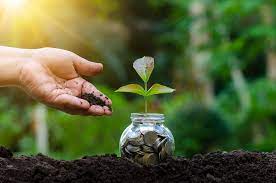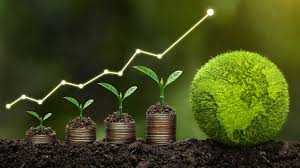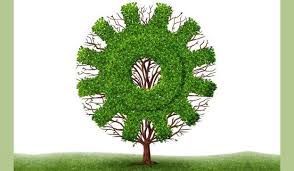The Transition to a Sustainable Future

The Green Economy and the Transition to a Sustainable Future
The transition to a green economy has become a central pillar in addressing the challenges of climate change, resource depletion, and social inequalities. This economic model, which aims to balance economic growth, social inclusion, and environmental sustainability, is one of the most promising pathways to a more sustainable future.
In this article, we will explore the concept of the green economy, its importance, and how it serves as a foundation for transforming global systems.
What Is the Green Economy?
The green economy is an economic framework designed to promote sustainability while fostering economic growth and reducing environmental risks. Unlike traditional economic models, the green economy emphasizes low-carbon solutions, resource efficiency, and social equity.
Key principles of the green economy include:
- Reducing Carbon Emissions: Encouraging renewable energy and energy efficiency.
- Promoting Circular Economy Practices: Recycling, reusing, and reducing waste.
- Preserving Biodiversity: Protecting natural ecosystems and promoting responsible land use.
- Ensuring Social Equity: Creating green jobs and promoting equal opportunities for all.

Why Is the Green Economy Important?
1. Combating Climate Change
One of the primary drivers of the green economy is the urgent need to mitigate climate change. With global temperatures rising and natural disasters becoming more frequent, the transition to sustainable practices is no longer optional. Renewable energy sources like solar and wind, along with energy-efficient technologies, are crucial components of this transition.
2. Preserving Natural Resources
The current rate of resource extraction is unsustainable. The green economy emphasizes resource efficiency and circular economy principles, ensuring that materials are reused and waste is minimized. This approach protects finite resources and reduces the environmental impact of production and consumption.
3. Driving Economic Growth
Contrary to the misconception that sustainability hinders economic growth, the green economy creates new opportunities for innovation and investment. Green sectors, such as renewable energy, sustainable agriculture, and eco-tourism, have shown significant potential for job creation and economic resilience.
4. Promoting Social Inclusion
A sustainable economy also prioritizes equity and inclusivity. By investing in green jobs and providing access to education and training in sustainable practices, the green economy ensures that communities are empowered and involved in the transition.

Key Sectors Driving the Green Economy
1. Renewable Energy
The shift from fossil fuels to renewable energy is a cornerstone of the green economy. Solar, wind, and hydropower are leading the way, providing cleaner alternatives that reduce greenhouse gas emissions and dependency on non-renewable resources.
2. Sustainable Agriculture
Agriculture is a significant contributor to greenhouse gas emissions. Sustainable farming practices, such as agroforestry, organic farming, and regenerative agriculture, play a vital role in reducing emissions and preserving soil health.
3. Green Transportation
Electric vehicles (EVs), public transportation, and cycling infrastructure are transforming the way we move. These innovations reduce air pollution and decrease our carbon footprint, making transportation more sustainable.
4. Circular Economy Practices
The circular economy is essential for reducing waste and maximizing resource use. By designing products for durability, repairability, and recyclability, companies can minimize their environmental impact and create value from materials that would otherwise go to waste.
Challenges in Transitioning to a Green Economy
While the benefits of a green economy are clear, the transition is not without challenges.
1. High Initial Costs
The upfront investment required for renewable energy infrastructure, green technologies, and sustainable practices can be significant. However, these costs are often offset by long-term savings and benefits.
2. Resistance to Change
Traditional industries and stakeholders may resist the shift to greener practices due to financial interests or fear of disruption. Clear policies and incentives are needed to overcome these barriers.
3. Lack of Awareness and Education
Many individuals and businesses lack awareness of sustainable practices or the tools to implement them. Education and training are crucial for empowering people to adopt greener habits.
4. Policy and Governance
Strong policies and governance are essential for guiding the transition. Governments must create frameworks that encourage sustainable investments, regulate harmful practices, and support vulnerable communities.

How Can Businesses and Individuals Support the Green Economy?
For Businesses:
- Adopt Sustainable Practices: Implement energy-efficient technologies and reduce waste in operations.
- Invest in Green Innovation: Support research and development of sustainable products and services.
- Engage in Corporate Social Responsibility (CSR): Align business goals with environmental and social objectives.
For Individuals:
- Reduce Energy Consumption: Opt for energy-efficient appliances and renewable energy sources at home.
- Support Sustainable Products: Choose products made from recycled materials or those with eco-friendly certifications.
- Advocate for Change: Support policies and initiatives that promote sustainability in your community.
The Role of Governments in Driving a Green Economy
Governments play a pivotal role in facilitating the transition to a green economy. Through policies, incentives, and regulations, they can encourage the adoption of sustainable practices across sectors. Key actions include:
- Implementing Carbon Taxes: Discouraging emissions-intensive practices and funding green initiatives.
- Providing Subsidies for Renewables: Making sustainable technologies more accessible.
- Enforcing Environmental Regulations: Ensuring that industries adhere to sustainability standards.
- Supporting Green Education: Investing in programs that prepare the workforce for green jobs.

The Future of the Green Economy
The transition to a green economy is not just a necessity but an opportunity. As nations, businesses, and individuals embrace sustainability, the potential for innovation and collaboration grows exponentially. The future of the green economy lies in global cooperation, technological advancement, and a shared commitment to creating a better planet for future generations.
Conclusion
The green economy represents a transformative shift towards a sustainable future. By focusing on renewable energy, sustainable practices, and social inclusion, it offers a pathway to address the pressing environmental and economic challenges of our time.
While the transition requires collective effort, the benefits far outweigh the challenges. Governments, businesses, and individuals all have a role to play in driving this change. Together, we can build a resilient and sustainable economy that benefits people and the planet alike.
For more insights on sustainability and green innovations, stay informed and committed to making a difference.
The Green Economy and the Transition to a Sustainable Future – https://youtu.be/zx04Kl8y4dE?si=OXRqm6cJ4Pa77jQu
Search – How Wars Damage the Environment: Impact on Water, Soil, and Biodiversity



